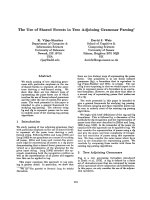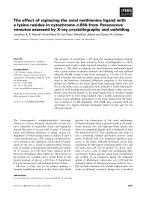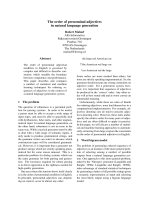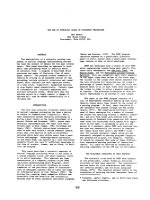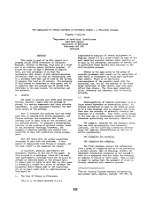Báo cáo khoa học: "The Effect of Translation Quality in MT-Based Cross-Language Information Retrieval" pptx
Bạn đang xem bản rút gọn của tài liệu. Xem và tải ngay bản đầy đủ của tài liệu tại đây (105.56 KB, 8 trang )
Proceedings of the 21st International Conference on Computational Linguistics and 44th Annual Meeting of the ACL, pages 593–600,
Sydney, July 2006.
c
2006 Association for Computational Linguistics
The Effect of Translation Quality in MT-Based
Cross-Language Information Retrieval
Jiang Zhu Haifeng Wang
Toshiba (China) Research and Development Center
5/F., Tower W2, Oriental Plaza, No.1, East Chang An Ave., Dong Cheng District
Beijing, 100738, China
{zhujiang, wanghaifeng}@rdc.toshiba.com.cn
Abstract
This paper explores the relationship be-
tween the translation quality and the re-
trieval effectiveness in Machine Transla-
tion (MT) based Cross-Language Infor-
mation Retrieval (CLIR). To obtain MT
systems of different translation quality,
we degrade a rule-based MT system by
decreasing the size of the rule base and
the size of the dictionary. We use the de-
graded MT systems to translate queries
and submit the translated queries of vary-
ing quality to the IR system. Retrieval ef-
fectiveness is found to correlate highly
with the translation quality of the queries.
We further analyze the factors that affect
the retrieval effectiveness. Title queries
are found to be preferred in MT-based
CLIR. In addition, dictionary-based deg-
radation is shown to have stronger impact
than rule-based degradation in MT-based
CLIR.
1 Introduction
Cross-Language Information Retrieval (CLIR)
enables users to construct queries in one lan-
guage and search the documents in another lan-
guage. CLIR requires that either the queries or
the documents be translated from a language into
another, using available translation resources.
Previous studies have concentrated on query
translation because it is computationally less ex-
pensive than document translation, which re-
quires a lot of processing time and storage costs
(Hull & Grefenstette, 1996).
There are three kinds of methods to perform
query translation, namely Machine Translation
(MT) based methods, dictionary-based methods
and corpus-based methods. Corresponding to
these methods, three types of translation re-
sources are required: MT systems, bilingual
wordlists and parallel or comparable corpora.
CLIR effectiveness depends on both the design
of the retrieval system and the quality of the
translation resources that are used.
In this paper, we explore the relationship be-
tween the translation quality of the MT system
and the retrieval effectiveness. The MT system
involved in this research is a rule-based English-
to-Chinese MT (ECMT) system. We degrade the
MT system in two ways. One is to degrade the
rule base of the system by progressively remov-
ing rules from it. The other is to degrade the dic-
tionary by gradually removing word entries from
it. In both methods, we observe successive
changes on translation quality of the MT system.
We conduct query translation with the degraded
MT systems and obtain translated queries of
varying quality. Then we submit the translated
queries to the IR system and evaluate the per-
formance. Retrieval effectiveness is found to be
strongly influenced by the translation quality of
the queries. We further analyze the factors that
affect the retrieval effectiveness. Title queries are
found to be preferred in MT-based query transla-
tion. In addition, the size of the dictionary is
shown to have stronger impact on retrieval effec-
tiveness than the size of the rule base in MT-
based query translation.
The remainder of this paper is organized as
follows. In section 2, we briefly review related
work. In section 3, we introduce two systems
involved in this research: the rule-based ECMT
system and the KIDS IR system. In section 4, we
describe our experimental method. Section 5 and
section 6 reports and discusses the experimental
results. Finally we present our conclusion and
future work in section 7.
593
2 Related Work
2.1 Effect of Translation Resources
Previous studies have explored the effect of
translation resources such as bilingual wordlists
or parallel corpora on CLIR performance.
Xu and Weischedel (2000) measured CLIR
performance as a function of bilingual dictionary
size. Their English-Chinese CLIR experiments
on TREC 5&6 Chinese collections showed that
the initial retrieval performance increased
sharply with lexicon size but the performance
was not improved after the lexicon exceeded
20,000 terms. Demner-Fushman and Oard (2003)
identified eight types of terms that affected re-
trieval effectiveness in CLIR applications
through their coverage by general-purpose bilin-
gual term lists. They reported results from an
evaluation of the coverage of 35 bilingual term
lists in news retrieval application. Retrieval ef-
fectiveness was found to be strongly influenced
by term list size for lists that contain between
3,000 and 30,000 unique terms per language.
Franz et al. (2001) investigated the CLIR per-
formance as a function of training corpus size for
three different training corpora and observed ap-
proximately logarithmically increased perform-
ance with corpus size for all the three corpora.
Kraaij (2001) compared three types of translation
resources for bilingual retrieval based on query
translation: a bilingual machine-readable diction-
ary, a statistical dictionary based on a parallel
web corpus and the Babelfish MT service. He
drew a conclusion that the mean average preci-
sion of a run was proportional to the lexical cov-
erage. McNamee and Mayfield (2002) examined
the effectiveness of query expansion techniques
by using parallel corpora and bilingual wordlists
of varying quality. They confirmed that retrieval
performance dropped off as the lexical coverage
of translation resources decreased and the rela-
tionship was approximately linear.
Previous research mainly focused on studying
the effectiveness of bilingual wordlists or parallel
corpora from two aspects: size and lexical cover-
age. Kraaij (2001) examined the effectiveness of
MT system, but also from the aspect of lexical
coverage. Why lack research on analyzing effect
of translation quality of MT system on CLIR
performance? The possible reason might be the
problem on how to control the translation quality
of the MT system as what has been done to bi-
lingual wordlists or parallel corpora. MT systems
are usually used as black boxes in CLIR applica-
tions. It is not very clear how to degrade MT
software because MT systems are usually opti-
mized for grammatically correct sentences rather
than word-by-word translation.
2.2 MT-Based Query Translation
MT-based query translation is perhaps the most
straightforward approach to CLIR. Compared
with dictionary or corpus based methods, the
advantage of MT-based query translation lies in
that technologies integrated in MT systems, such
as syntactic and semantic analysis, could help to
improve the translation accuracy (Jones et al.,
1999). However, in a very long time, fewer ex-
periments with MT-based methods have been
reported than with dictionary-based methods or
corpus-based methods. The main reasons include:
(1) MT systems of high quality are not easy to
obtain; (2) MT systems are not available for
some language pairs; (3) queries are usually
short or even terms, which limits the effective-
ness of MT-based methods. However, recent re-
search work on CLIR shows a trend to adopt
MT-based query translation. At the fifth NTCIR
workshop, almost all the groups participating in
Bilingual CLIR and Multilingual CLIR tasks
adopt the query translation method using MT
systems or machine-readable dictionaries (Ki-
shida et al., 2005). Recent research work also
proves that MT-based query translation could
achieve comparable performance to other meth-
ods (Kishida et al., 2005; Nunzio et al., 2005).
Considering more and more MT systems are be-
ing used in CLIR, it is of significance to care-
fully analyze how the performance of MT system
may influence the retrieval effectiveness.
3 System Description
3.1 The Rule-Based ECMT System
The MT system used in this research is a rule-
based ECMT system. The translation quality of
this ECMT system is comparable to the best
commercial ECMT systems. The basis of the
system is semantic transfer (Amano et al., 1989).
Translation resources comprised in this system
include a large dictionary and a rule base. The
rule base consists of rules of different functions
such as analysis, transfer and generation.
3.2 KIDS IR System
KIDS is an information retrieval engine that is
based on morphological analysis (Sakai et al.,
2003). It employs the Okapi/BM25 term weight-
ing scheme, as fully described in (Robertson &
Walker, 1999; Robertson & Sparck Jones, 1997).
594
To focus our study on the relationship between
MT performance and retrieval effectiveness, we
do not use techniques such as pseudo-relevance
feedback although they are available and are
known to improve IR performance.
4 Experimental Method
To obtain MT systems of varying quality, we
degrade the rule-based ECMT system by impair-
ing the translation resources comprised in the
system. Then we use the degraded MT systems
to translate the queries and evaluate the transla-
tion quality. Next, we submit the translated que-
ries to the KIDS system and evaluate the re-
trieval performance. Finally we calculate the cor-
relation between the variation of translation qual-
ity and the variation of retrieval effectiveness to
analyze the relationship between MT perform-
ance and CLIR performance.
4.1 Degradation of MT System
In this research, we degrade the MT system in
two ways. One is rule-based degradation, which
is to decrease the size of the rule base by ran-
domly removing rules from the rule base. For
sake of simplicity, in this research we only con-
sider transfer rules that are used for transferring
the source language to the target language and
keep other kinds of rules untouched. That is, we
only consider the influence of transfer rules on
translation quality
1
. We first randomly divide the
rules into segments of equal size. Then we re-
move the segments from the rule base, one at
each time and obtain a group of degraded rule
bases. Afterwards, we use MT systems with the
degraded rule bases to translate the queries and
get groups of translated queries, which are of
different translation quality.
The other is dictionary-based degradation,
which is to decrease the size of the dictionary by
randomly removing a certain number of word
entries from the dictionary iteratively. Function
words are not removed from the dictionary. Us-
ing MT systems with the degraded dictionaries,
we also obtain groups of translated queries of
different translation quality.
4.2 Evaluation of Performance
We measure the performance of the MT system
by translation quality and use NIST score as the
evaluation measure (Doddington, 2002). The
1
In the following part of this paper, rules refer to transfer
rules unless explicitly stated.
NIST scores reported in this paper are generated
by NIST scoring toolkit
2
.
For retrieval performance, we use Mean Aver-
age Precision (MAP) as the evaluation measure
(Voorhees, 2003). The MAP values reported in
this paper are generated by trec_eval toolkit
3
,
which is the standard tool used by TREC for
evaluating an ad hoc retrieval run.
5 Experiments
5.1 Data
The experiments are conducted on the TREC5&6
Chinese collection. The collection consists of
document set, topic set and the relevance judg-
ment file.
The document set contains articles published
in People's Daily from 1991 to 1993, and news
articles released by the Xinhua News Agency in
1994 and 1995. It includes totally 164,789
documents. The topic set contains 54 topics. In
the relevance judgment file, a binary indication
of relevant (1) or non-relevant (0) is given.
<top>
<num> Number: CH41
<C-title>
京九铁路的桥梁隧道工程
<E-title> Bridge and Tunnel Construction for
the Beijing-Kowloon Railroad
<C-desc> Description:
京九铁路,桥梁,隧道,贯通,特大桥,
<E-desc> Description:
Beijing-Kowloon Railroad, bridge, tunnel,
connection, very large bridge
<C-narr> Narrative:
相关文件必须提到京九铁路的桥梁隧道工
程,包括地点、施工阶段、长度.
<E-narr> Narrative:
A relevant document discusses bridge and
tunnel construction for the Beijing-Kowloon
Railroad, including location, construction
status, span or length.
</top>
Figure 1. Example of TREC Topic
5.2 Query Formulation & Evaluation
For each TREC topic, three fields are provided:
title, description and narrative, both in Chinese
and English, as shown in figure 1. The title field
is the statement of the topic. The description
2
The toolkit could be downloaded from:
3
The toolkit could be downloaded from:
595
field lists some terms that describe the topic. The
narrative field provides a complete description
of document relevance for the assessors. In our
experiments, we use two kinds of queries: title
queries (use only the title field) and desc queries
(use only the description field). We do not use
narrative field because it is the criteria used by
the assessors to judge whether a document is
relevant or not, so it usually contains quite a
number of unrelated words.
Title queries are one-sentence queries. When
use NIST scoring tool to evaluate the translation
quality of the MT system, reference translations
of source language sentences are required. NIST
scoring tool supports multi references. In our
experiments, we introduce two reference transla-
tions for each title query. One is the Chinese title
(C-title) in title field of the original TREC topic
(reference translation 1); the other is the transla-
tion of the title query given by a human transla-
tor (reference translation 2). This is to alleviate
the bias on translation evaluation introduced by
only one reference translation. An example of
title query and its reference translations are
shown in figure 2. Reference 1 is the Chinese
title provided in original TREC topic. Reference
2 is the human translation of the query. For this
query, the translation output generated by the
MT system is "在中国的机器人技术研究". If
only use reference 1 as reference translation, the
system output will not be regarded as a good
translation. But in fact, it is a good translation for
the query. Introducing reference 2 helps to alle-
viate the unfair evaluation.
Title Query: CH27
<query>
Robotics Research in China
<reference 1>
中国在机器人方面的研制
<reference 2>
中国的机器人技术
Figure 2. Example of Title Query
A desc query is not a sentence but a string of
terms that describes the topic. The term in the
desc query is either a word, a phrase or a string
of words. A desc query is not a proper input for
the MT system. But the MT system still works. It
translates the desc query term by term. When the
term is a word or a phrase that exists in the dic-
tionary, the MT system looks up the dictionary
and takes the first translation in the entry as the
translation of the term without any further analy-
sis. When the term is a string of words such as
"number(数量) of(的) infections(感染)", the sys-
tem translates the term into "感染数量". Besides
using the Chinese description (C-desc) in the
description field of the original TREC topic as
the reference translation of each desc query, we
also have the human translator give another ref-
erence translation for each desc query. Compari-
son on the two references shows that they are
very similar to each other. So in our final ex-
periments, we use only one reference for each
desc query, which is the Chinese description (C-
desc) provided in the original TREC topic. An
example of desc query and its reference transla-
tion is shown in figure 3.
Desc Query: CH22
<query>
malaria, number of deaths, number of infections
<reference>
疟疾,死亡人数,感染病例
Figure 3. Example of Desc Query
5.3 Runs
Previous studies (Kwok, 1997; Nie et al., 2000)
proved that using words and n-grams indexes
leads to comparable performance for Chinese IR.
So in our experiments, we use bi-grams as index
units.
We conduct following runs to analyze the rela-
tionship between MT performance and CLIR
performance:
• rule-title: MT-based title query transla-
tion with degraded rule base
• rule-desc: MT-based desc query transla-
tion with degraded rule base
• dic-title: MT-based title query translation
with degraded dictionary
• dic-desc: MT-based desc query transla-
tion with degraded dictionary
For baseline comparison, we conduct Chinese
monolingual runs with title queries and desc que-
ries.
5.4 Monolingual Performance
The results of Chinese monolingual runs are
shown in Table 1.
Run MAP
title-cn1
0.3143
title-cn2
0.3001
desc-cn
0.3514
Table 1. Monolingual Results
596
title-cn1: use reference translation 1 of each ti-
tle query as Chinese query
title-cn2: use reference translation 2 of each ti-
tle query as Chinese query
desc-cn: use reference translation of each desc
query as Chinese query
Among all the three monolingual runs, desc-cn
achieves the best performance. Title-cn1
achieves better performance than title-cn2, which
indicates directly using Chinese title as Chinese
query performs better than using human transla-
tion of title query as Chinese query.
5.5 Results on Rule-Based Degradation
There are totally 27,000 transfer rules in the rule
base. We use all these transfer rules in the ex-
periment of rule-based degradation. The 27,000
rules are randomly divided into 36 segments,
each of which contains 750 rules. To degrade the
rule base, we start with no degradation, then we
remove one segment at each time, up to a com-
plete degradation with all segments removed.
With each of the segment removed from the rule
base, the MT system based on the degraded rule
base produces a group of translations for the in-
put queries. The completely degraded system
with all segments removed could produce a
group of rough translations for the input queries.
Figure 4 and figure 5 show the experimental
results on title queries (rule-title) and desc que-
ries (rule-desc) respectively.
Figure 4(a) shows the changes of translation
quality of the degraded MT systems on title que-
ries. From the result, we observe a successive
change on MT performance. The fewer rules, the
worse translation quality achieves. The NIST
score varies from 7.3548 at no degradation to
5.9155 at complete degradation. Figure 4(b)
shows the changes of retrieval performance by
using the translations generated by the degraded
MT systems as queries. The MAP varies from
0.3126 at no degradation to 0.2810 at complete
degradation. Comparison on figure 4(a) and 4(b)
indicates similar variations between translation
quality and retrieval performance. The better the
translation quality, the better the retrieval per-
formance is.
Figure 5(a) shows the changes of translation
quality of the degraded MT systems on desc que-
ries. Figure 5(b) shows the corresponding
changes of retrieval performance. We observe a
similar relationship between MT performance
and retrieval performance as to the results based
5.8000
6.0000
6.2000
6.4000
6.6000
6.8000
7.0000
7.2000
7.4000
7.6000
0 4 8 1216202428323640
MT System with Degraded Rule Base
NIST Score
Figure 4(a). MT Performance on Rule-based
Degradation with Title Query
4.8400
4.8600
4.8800
4.9000
4.9200
4.9400
4.9600
4.9800
5.0000
5.0200
5.0400
0 4 8 1216202428323640
MT System with Degraded Rule Base
NIST Score
Figure 5(a). MT Performance on Rule-based
Degradation with Desc Query
0.2800
0.2850
0.2900
0.2950
0.3000
0.3050
0.3100
0.3150
0.3200
0 4 8 1216202428323640
MT System with Degraded Rule Base
MAP
Figure 4(b). Retrieval Effectiveness on Rule-
based Degradation with Title Query
0.2750
0.2770
0.2790
0.2810
0.2830
0.2850
0.2870
0.2890
0 4 8 1216202428323640
MT System with Degraded Rule Base
MAP
Figure 5(b). Retrieval Effectiveness on Rule-
based Degradation with Desc Query
597
5.8000
6.0000
6.2000
6.4000
6.6000
6.8000
7.0000
7.2000
7.4000
7.6000
0 4 8 1216202428323640
MT System with Degraded Dcitionary
NIST Score
Figure 6(a). MT Performance on Dictionary-
based Degradation with Title Query
4.4000
4.5000
4.6000
4.7000
4.8000
4.9000
5.0000
5.1000
0 4 8 12 16 20 24 28 32 36 40
MT System with Degraded Dictionary
NIST Score
Figure 7(a). MT Performance on Dictionary-
based Degradation with Desc Query
0.1800
0.2000
0.2200
0.2400
0.2600
0.2800
0.3000
0.3200
0 4 8 1216202428323640
MT System with Degraded Dcitionary
MAP
Figure 6(b). Retrieval Effectiveness on Diction-
ary-based Degradation with Title Query
0.2400
0.2450
0.2500
0.2550
0.2600
0.2650
0.2700
0.2750
0.2800
0.2850
0.2900
0 4 8 1216202428323640
MT System with Degraded Dictionary
MAP
Figure 7(b). Retrieval Effectiveness on Diction-
ary-based Degradation with Desc Query
on title queries. The NIST score varies from
5.0297 at no degradation to 4.8497 at complete
degradation. The MAP varies from 0.2877 at no
degradation to 0.2759 at complete degradation.
5.6 Results on Dictionary-Based Degrada-
tion
The dictionary contains 169,000 word entries. To
make the results on dictionary-based degradation
comparable to the results on rule-based degrada-
tion, we degrade the dictionary so that the varia-
tion interval on translation quality is similar to
that of the rule-based degradation. We randomly
select 43,200 word entries for degradation. These
word entries do not include function words. We
equally split these word entries into 36 segments.
Then we remove one segment from the diction-
ary at each time until all the segments are re-
moved and obtain 36 degraded dictionaries. We
use the MT systems with the degraded dictionar-
ies to translate the queries and observe the
changes on translation quality and retrieval per-
formance. The experimental results on title que-
ries (dic-title) and desc queries (dic-desc) are
shown in figure 6 and figure 7 respectively.
From the results, we also observe a similar rela-
tionship between translation quality and retrieval
performance as what we have observed in the
rule-based degradation. For both title queries and
desc queries, the larger the dictionary size, the
better the NIST score and MAP is. For title que-
ries, the NIST score varies from 7.3548 at no
degradation to 6.0067 at complete degradation.
The MAP varies from 0.3126 at no degradation
to 0.1894 at complete degradation. For desc que-
ries, the NIST score varies from 5.0297 at no
degradation to 4.4879 at complete degradation.
The MAP varies from 0.2877 at no degradation
to 0.2471 at complete degradation.
5.7 Summary of the Results
Here we summarize the results of the four runs in
Table 2.
Run NIST Score MAP
title queries
No degradation 7.3548 0.3126
Complete: rule-title 5.9155 0.2810
Complete: dic-title 6.0067 0.1894
desc queries
No degradation 5.0297 0.2877
Complete: rule-desc 4.8497 0.2759
Complete: dic-desc 4.4879 0.2471
Table 2. Summary of Runs
598
6 Discussion
Based on our observations, we analyze the corre-
lations between NIST scores and MAPs, as listed
in Table 3. In general, there is a strong correla-
tion between translation quality and retrieval ef-
fectiveness. The correlations are above 95% for
all of the four runs, which means in general, a
better performance on MT will lead to a better
performance on retrieval.
Run Correlation
rule-title
0.9728
rule-desc
0.9500
dic-title
0.9521
dic-desc
0.9582
Table 3. Correlation Between Translation Qual-
ity & Retrieval Effectiveness
6.1 Impacts of Query Format
For Chinese monolingual runs, retrieval based on
desc queries achieves better performance than
the runs based on title queries. This is because a
desc query consists of terms that relate to the
topic, i.e., all the terms in a desc query are pre-
cise query terms. But a title query is a sentence,
which usually introduces words that are unre-
lated to the topic.
Results on bilingual retrieval are just contrary
to monolingual ones. Title queries perform better
than desc queries. Moreover, MAP at no degra-
dation for title queries is 0.3126, which is about
99.46% of the performance of monolingual run
title-cn1, and outperforms the performance of
title-cn2 run. But MAP at no degradation for
desc queries is 0.2877, which is just 81.87% of
the performance of the monolingual run desc-cn.
Comparison on the results shows that the MT
system performs better on title queries than on
desc queries. This is reasonable because desc
queries are strings of terms, however the MT
system is optimized for grammatically correct
sentences rather than word-by-word translation.
Considering the correlation between translation
quality and retrieval effectiveness, it is rational
that title queries achieve better results on re-
trieval than desc queries.
6.2 Impacts of Rules and Dictionary
Table 4 shows the fall of NIST score and MAP at
complete degradation compared with NIST score
and MAP achieved at no degradation.
Comparison on the results of title queries
shows that similar variation of translation quality
leads to quite different variation on retrieval ef-
fectiveness. For rule-title run, 19.57% reduction
in translation quality results in 10.11% reduction
in retrieval effectiveness. But for dic-title run,
18.33% reduction in translation quality results in
39.41% reduction in retrieval effectiveness. This
indicates that retrieval effectiveness is more sen-
sitive to the size of the dictionary than to the size
of the rule base for title queries. Why dictionary-
based degradation has stronger impact on re-
trieval effectiveness than rule-based degradation?
This is because retrieval systems are typically
more tolerant of syntactic than semantic transla-
tion errors (Fluhr, 1997). Therefore although
syntactic errors caused by the degradation of the
rule base result in a decrease of translation qual-
ity, they have smaller impacts on retrieval effec-
tiveness than the word translation errors caused
by the degradation of dictionary.
For desc queries, there is no big difference be-
tween dictionary-based degradation and rule-
based degradation. This is because the MT sys-
tem translates the desc queries term by term, so
degradation of rule base mainly results in word
translation errors instead of syntactic errors.
Thus, degradation of dictionary and rule base has
similar effect on retrieval effectiveness.
Run NIST Score Fall MAP Fall
title queries
rule-title
19.57% 10.11%
dic-title
18.33% 39.41%
desc queries
rule-desc
3.58% 4.10%
dic-desc
10.77% 14.11%
Table 4. Fall on Translation Quality & Retrieval
Effectiveness
7 Conclusion and Future Work
In this paper, we investigated the effect of trans-
lation quality in MT-based CLIR. Our study
showed that the performance of MT system and
IR system correlates highly with each other. We
further analyzed two main factors in MT-based
CLIR. One factor is the query format. We con-
cluded that title queries are preferred for MT-
based CLIR because MT system is usually opti-
mized for translating sentences rather than words.
The other factor is the translation resources com-
prised in the MT system. Our observation
showed that the size of the dictionary has a
stronger effect on retrieval effectiveness than the
size of the rule base in MT-based CLIR. There-
fore in order to improve the retrieval effective-
ness of a MT-based CLIR application, it is more
599
effective to develop a larger dictionary than to
develop more rules. This introduces another in-
teresting question relating to MT-based CLIR.
That is how CLIR can benefit further from MT.
Directly using the translations generated by the
MT system may not be the best choice for the IR
system. There are rich features generated during
the translation procedure. Will such features be
helpful to CLIR? This question is what we would
like to answer in our future work.
References
Shin-ya Amano, Hideki Hirakawa, Hirosysu Nogami,
and Akira Kumano. 1989. The Toshiba Machine
Translation System. Future Computing System,
2(3):227-246.
Dina Demner-Fushman, and Douglas W. Oard. 2003.
The Effect of Bilingual Term List Size on Diction-
ary-Based Cross-Language Information Retrieval.
In Proc. of the 36th Hawaii International Confer-
ence on System Sciences (HICSS-36), pages 108-
117.
George Doddington. 2002. Automatic Evaluation of
Machine Translation Quality Using N-gram Co-
occurrence Statistics. In Proc. of the Second Inter-
national Conference on Human Language Tech-
nology (HLT-2002), pages 138-145.
Christian Fluhr. 1997. Multilingual Information Re-
trieval. In Ronald A Cole, Joseph Mariani, Hans
Uszkoreit, Annie Zaenen, and Victor Zue (Eds.),
Survey of the State of the Art in Human Language
Technology, pages 261-266, Cambridge University
Press, New York.
Martin Franz, J. Scott McCarley, Todd Ward, and
Wei-Jing Zhu. 2001. Quantifying the Utility of
Parallel Corpora. In Proc. of the 24th Annual ACM
Conference on Research and Development in In-
formation Retrieval (SIGIR-2001), pages 398-399.
David A. Hull and Gregory Grefenstette. 1996. Que-
rying Across Languages: A Dictionary-Based Ap-
proach to Multilingual Information Retrieval. In
Proc. of the 19th Annual ACM Conference on Re-
search and Development in Information Retrieval
(SIGIR-1996), pages 49-57.
Gareth Jones, Tetsuya Sakai, Nigel Collier, Akira
Kumano and Kazuo Sumita. 1999. Exploring the
Use of Machine Translation Resources for English-
Japanese Cross-Language Infromation Retrieval. In
Proc. of MT Summit VII Workshop on Machine
Translation for Cross Language Information Re-
trieval, pages 15-22.
Kazuaki Kishida, Kuang-hua Chen, Sukhoon Lee,
Kazuko Kuriyama, Noriko Kando, Hsin-Hsi Chen,
and Sung Hyon Myaeng. 2005. Overview of CLIR
Task at the Fifth NTCIR Workshop. In Proc. of the
NTCIR-5 Workshop Meeting, pages 1-38.
Wessel Kraaij. 2001. TNO at CLEF-2001: Comparing
Translation Resources. In Proc. of the CLEF-2001
Workshop, pages 78-93.
Kui-Lam Kwok. 1997. Comparing Representation in
Chinese Information Retrieval. In Proc. of the 20th
Annual ACM Conference on Research and Devel-
opment in Information Retrieval (SIGIR-1997),
pages 34-41.
Paul McNamee and James Mayfield. 2002. Compar-
ing Cross-Language Query Expansion Techniques
by Degrading Translation Resources. In Proc. of
the 25th Annual ACM Conference on Research and
Development in Information Retrieval (SIGIR-
2002), pages 159-166.
Jian-Yun Nie, Jianfeng Gao, Jian Zhang, and Ming
Zhou. 2000. On the Use of Words and N-grams for
Chinese Information Retrieval. In Proc. of the Fifth
International Workshop on Information Retrieval
with Asian Languages (IRAL-2000), pages 141-148.
Giorgio M. Di Nunzio, Nicola Ferro, Gareth J. F.
Jones, and Carol Peters. 2005. CLEF 2005: Ad
Hoc Track Overview. In C. Peters (Ed.), Working
Notes for the CLEF 2005 Workshop.
Stephen E. Robertson and Stephen Walker. 1999.
Okapi/Keenbow at TREC-8. In Proc. of the Eighth
Text Retrieval Conference (TREC-8), pages 151-
162.
Stephen E. Robertson and Karen Sparck Jones. 1997.
Simple, Proven Approaches to Text Retrieval.
Technical Report 356, Computer Laboratory, Uni-
versity of Cambridge, United Kingdom.
Tetsuya Sakai, Makoto Koyama, Masaru Suzuki, and
Toshihiko Manabe. 2003. Toshiba KIDS at
NTCIR-3: Japanese and English-Japanese IR. In
Proc. of the Third NTCIR Workshop on Research
in Information Retrieval, Automatic Text Summari-
zation and Question Answering (NTCIR-3), pages
51-58.
Ellen M. Voorhees. 2003. Overview of TREC 2003.
In Proc. of the Twelfth Text Retrieval Conference
(TREC 2003), pages 1-13.
Jinxi Xu and Ralph Weischedel. 2000. Cross-lingual
Information Retrieval Using Hidden Markov Mod-
els. In Proc. of the 2000 Joint SIGDAT Conference
on Empirical Methods in Natural Language Proc-
essing and Very Large Corpora (EMNLP/VLC-
2000), pages 95-103.
600





